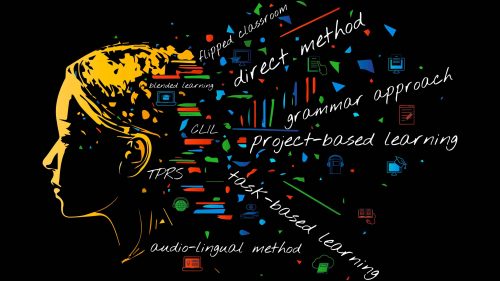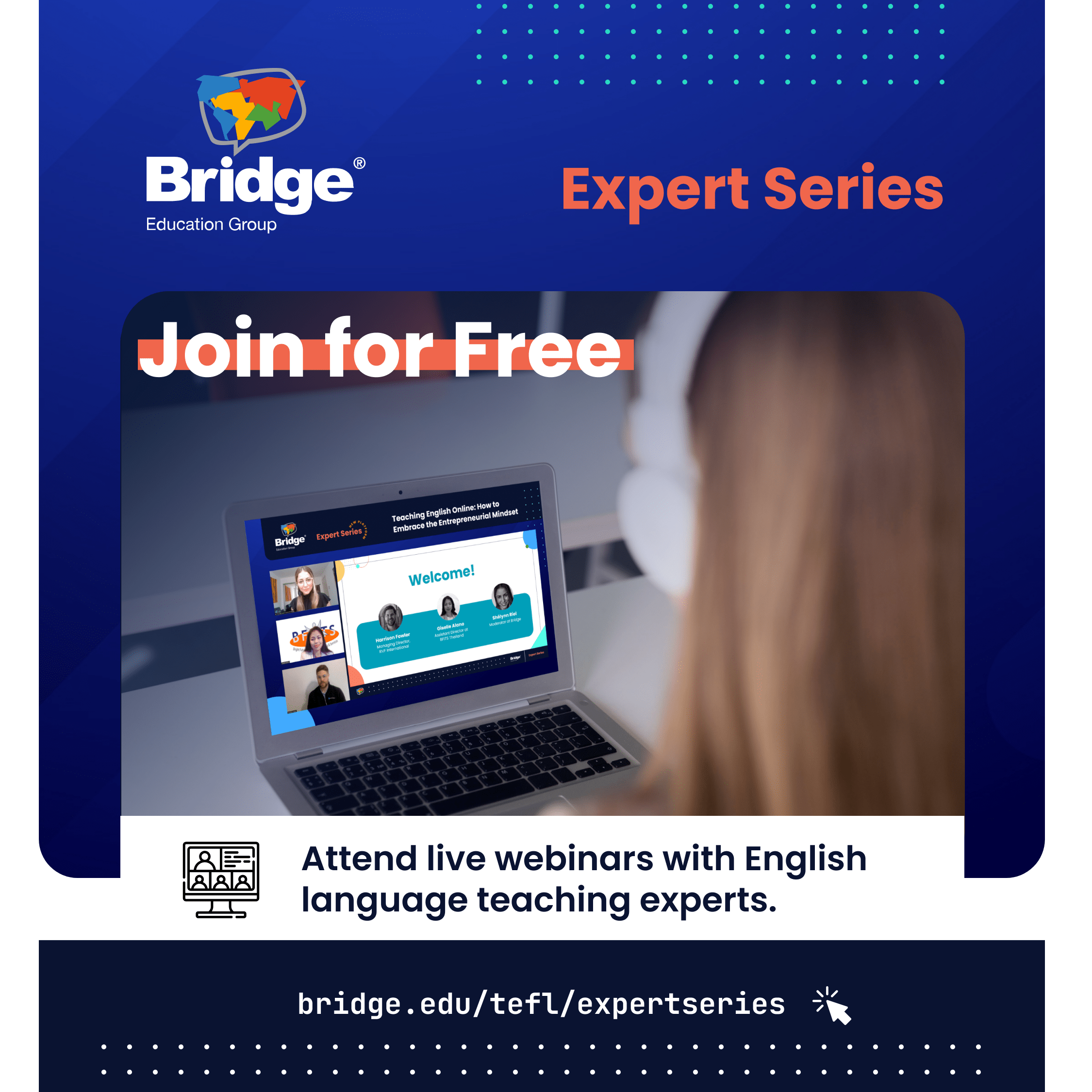Choosing an effective foreign language teaching methodology is a concern common to many language teachers. In the case of teaching English as a second or foreign language, this concern is amplified by the unique place English occupies among world languages and the multifaceted profile of English language learners. Some teachers remain loyal to a specific teaching strategy throughout their careers, while others try different approaches, searching for that magic bullet that will deliver language proficiency for their students in the limited amount of available class hours.
With 40 years of ESL/EFL teacher training, Bridge has been in the front row of evolving English language learning methodologies, training teachers to identify the best instructional methods and practices, and highlighting ways to identify student learning styles and needs that often drive effective methodology choices. Foundational courses such as the 40-hour Basic TEFL/TESOL Certificate, 60-hour Introductory Educator TEFL/TESOL Certificate and 100-hour Introductory EducatorPlus TEFL/TESOL Certificate provide the foundational skills needed to teach English language learners. Over time, Specialized Certifications were added to provide niche training. These included the Teaching English Online suite of courses, Teaching English to Young Learners and Teenagers courses and Teaching Business English.
What methodologies do work and how do I choose when to use them?
Each course includes training in current learning methodologies specific to the context of the course, but Bridge also developed certifications and training in some of the most relevant methodologies for English language learning, such as Specialized Certifications in Foundational CLIL Methodology and Advanced CLIL Methodology, to provide a deeper dive into relevant development and execution of effective methods of teaching and learning.
While some may claim to have “cracked the code” and found the method through which learners will most quickly or most effectively learn the English language, the complex reality of language learning indicates a need for multiple strategies of learning, whether that learning takes place in person or online. If there is no single “magic” method to learning English, that leaves teachers with the question, “What methodologies do work and how do I choose when to use them?” To answer this question, we need first to consider the peculiar position occupied by English among world languages and then look at the diverse characteristics of English language learners and how this diversity impacts the choice of methodology.
Interested in learning more about professional development to sharpen your teaching skills? Read Upskilling Opportunities for ELT Industry Grow With Global Shifts, Rise of Private Sector EFL Companies.

English as a world language
Today, English is possibly the most widely taught and spoken language in the world. It is the de jure or de facto official language in 67 countries and 27 non-sovereign territories. According to some estimates, English is spoken by two billion people worldwide, with native speakers making up about four-hundred million of them. After World War II, with the ascent of the United States as the main economic and political power, English became the lingua franca for business, diplomacy and travel. It occupies an equally central position in the sphere of academia and research. Therefore, knowledge of English is essential for many fields of study, from the humanities to science and everyday communication.
Bridge Languages, the corporate language training division of Bridge, continues to expand its language training partnerships, particularly in Latin America, where Business English training is in demand among many multinational companies. As businesses evolve with increasing technological developments, many industries have developed language programs to provide employees with English language training to meet global communication demands. In many cases, English for Specific Purposes (ESP) courses are needed to provide industry-specific English language training, with instruction focused on English for fields such as medicine, aviation or engineering. Bridge Languages learning paths include ESP training for a variety of industries.
English’s large geographical distribution has produced many regional variants differing in lexicon and inflection, adding complexity to the language. While British and American English have historically been the most established and influential varieties, we now must also consider English’s diverse cultural implications. With an estimated two billion people speaking English worldwide, English has become a global language, with varied dialects and accents reflecting many cultures. In response to the evolving nature of the language, Bridge supports the global nature of English, providing teachers with tips for teaching English as a global language. It is important to also consider how this diversity impacts the choice of teaching methodologies.
Interested in learning how to teach English as a Global language? Learn more about Bridge’s Teaching English as a Global Language Micro-credential.
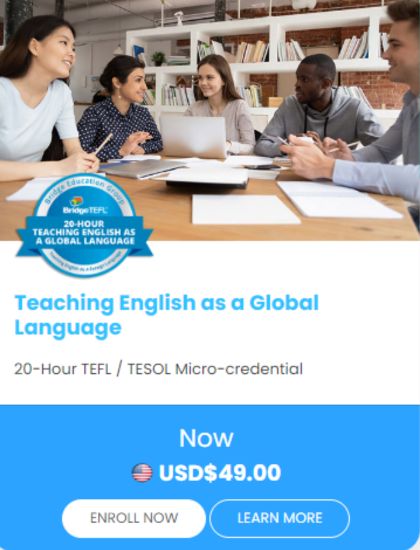
Diverse profiles of English language learners
English language learners are a disparate student body, as diverse as the cultural and socio-economic context in which they live. To illustrate their complexity, let’s consider school-age English learners and how their national context can influence teachers’ choice of methodologies.
In some anglophone countries like the U.S. and the UK, English language learners make up a high percentage of the student population (respectively 10 and 20 percent). However, while most learners in the UK are foreign-born, in the U.S., only 23 percent of K-12 students with limited English proficiency were born in another country. In both countries, students’ performance in English appears to be linked more to their socioeconomic status than to their immigration status or ethnic background, with pupils from a low socioeconomic status underperforming across all school subjects. Thus, their challenges may not lay simply in having to master a second language, and the choice of methodologies should take into account other aspects like integration into the social structure and the need for additional in-school support.
In many other countries around the world, the study of English is mandatory for all school-age students. Stakes are high for many English language learners around the world. In China, studying English is compulsory, and it occupies an essential place in children’s education. It is understood that students need to master English to access good jobs. Many Chinese students also need English to pass exams like the GRE and the TOEFL and to study overseas. When teaching Chinese students, ESL/EFL instructors should consider the way these children learn. Establishing routines, leveraging Chinese students’ aptitude for memorization, setting clear goals and understanding a few essential differences between English and Chinese (the challenges students encounter in studying English) can help teachers choose an appropriate methodology.
In some countries like India, multilingualism is the norm, and children grow up speaking more than one language. This will likely give them an advantage in learning L2 over children living in monolingual countries. But, although English is considered a second language in India and its study is mandatory, its use is still primarily the purview of the elite, with only 10 percent of the population speaking it proficiently. Challenges students encounter in learning English are mostly related to how the language is taught and include an excessive emphasis on grammar instead of fluency, the tendency to translate from the L1 to the L2, which produces a language that sounds unnatural to the native English speaker, and not enough exposure to the target language (TL). In India, like in China, there is enormous pressure to learn English, a language seen as the way to better jobs and careers.

In South America, Argentina leads the region in English proficiency. What makes English so popular in Argentina is the hope that it may open the way to better jobs and career pathways. In recent years, the teaching approach to English has started to emphasize a multicultural and multilingual perspective, placing English in a global context and encouraging students to grant equal importance to their language and culture.
Regardless of their country of residence, English language learning students share some common characteristics.
-
They live in countries where English is the official language or essential for work or study.
-
Students who relocate to English-speaking countries come from disparate cultural, linguistic and economic backgrounds and must face other challenges besides mastering English. Many English language students attend schools where English is the primary language of instruction. Lack of English fluency and inability to communicate effectively can cause students to be misjudged by their teachers as being underperforming even in subjects in which they are proficient.
-
They are aware of the high stakes involved in acquiring English proficiency. Fluency in English can enhance their career, open new career pathways or be essential to study and work at any level. This can generate anxiety in learners. The effect of anxiety on English language learners is a well-known phenomenon “which involves stages of communicative anxiety, fear of adverse assessment, test anxiety and anxiety of the English classroom.”
-
Learners have disparate needs and learning objectives that depend on their age, location, the reason for learning English (academic, daily communication, business, etc.) and language learning aptitude.
Given the complexity of the English language learner student profile, it is not reasonable to assume that a single methodology can be effective in all cases. The individual needs of students should drive the choice of teaching methodologies.
Certain aspects of those methodologies (e.g., grammar rules/structures in grammar/translation or repetition drills in audiolingual method) can still be used for students with certain learning styles or for specific proficiency levels.
Eric Peterson at Westcliff University in the U.S. said teachers should keep in mind students’ backgrounds, learning styles, interests and levels of proficiency when considering appropriate teaching methodologies, noting that in any case, instruction should be student-centered.
When asked whether there is still space for older methodologies, he said there are still certain aspects of some of the older methodologies that can play a part in the classroom.
“Certain aspects of those methodologies (e.g., grammar rules/structures in grammar/translation or repetition drills in audiolingual method) can still be used for students with certain learning styles or for specific proficiency levels,” Peterson said. “So, there is still space for these methodologies but they need to be implemented in a way that always promotes the student at the center of instruction.”
In addition, the method used to deliver instruction should be considered. In-person instruction differs from increasingly popular online instruction in several ways that also impact the choice of teaching strategies. With all this in mind, let’s look at the main approaches and methodologies available for ESL/EFL instruction.
If you live in a multicultural community, you are likely familiar with the phenomenon of code-switching. Learn about code-switching in EFL classrooms as well as when and how this practice may be used effectively.
Approaches and Methodologies for ESL/EFL Instruction
In English Language Teaching (ELT), the term “approach” refers to the philosophy or theoretical framework underlying language instruction. A methodology is the way that approach is implemented. The two terms are sometimes used interchangeably.
In this review of approaches and methodologies, we will start with the older approaches and evaluate if and in what context these approaches are still valid today.
1. Grammar/Translation Approach
Also called the Classical Method because it was largely used for teaching ancient Greek and Latin, this approach views languages and language learning primarily as a set of rules (grammar) and words (lexicon) to be memorized and then applied. Due to its focus on classical languages, the GTA was not geared toward oral communication but rather reading and writing. The approach originated in the 18th century and relied heavily on memorization and the internalization of grammar and vocabulary through exposure to texts. In its more recent version, the GTA teaching procedure consists of an analysis and explanation of grammar rules in the student’s native language; vocabulary lists to be memorized by the learner together with the grammar rules; grammar drills; and translation exercises.
Although partially fallen from favor, the GTA and the methods derived from it are still used today, and the GTA is still implicit in the organization of many textbooks. While not ideal for beginners, the GTA is valuable for high-intermediate and advanced students in an academic context, such as when studying literature, philology or linguistics. Approaching literary texts with the Grammar/Translation Approach encourages readers to focus closely on the subtleties of the language. Students trained in this method understand grammar and syntactical structures and, above all, how grammar, syntax and the choice of vocabulary all contribute to expressing meaning. In addition, the Grammar/Translation approach encourages the learner’s analytical abilities much more than other methods/approaches. In this respect, the method has value beyond mere language teaching.
Learn about some of the top strategies for teaching grammar to English language learners.

2. Direct Method
The Direct Method arose during the late 1800s to the early 1900s as a reaction to the Grammar Translation Approach. Where the GMA emphasized reading and writing, the Direct Method emphasized oral communication. Its motto is “demonstrate, don’t translate.” Instead of teaching the students grammar and vocabulary explicitly and practicing translation, the Direct Method relies on direct exposure to the language through listening, visuals and realia. Grammar is taught inductively, and only the target language is spoken in class. The Direct Method aims to have students strive to think in the target language from the outset. For this reason, examples, gestures and realia abound as there is a solid effort to contextualize the new language to make it understandable without resorting to the student’s native language. The Direct Method should properly be classified as part of the Natural Approach to language learning, were it not for the fact that it precedes it by several decades.
Read more about the Direct Method and four other ESL teaching methods every teacher should know.
3. Audiolingual Method
This method originated from the so-called “Army Method,” the intensive foreign language training program practiced by the U.S. Army during WWII. This emphasized memorization and repetition of basic language patterns to gradually learn how to speak the language and understand its elementary grammar structures. The Army Method subsequently morphed into the Aural-Oral Approach (developed by Charles Fries), which attached great importance to pronunciation and intonation and based language teaching on the “intensive oral drilling of its basic patterns.” The Audiolingual Method is essentially an evolution of the Army Method and the Aural-Oral Approach. It is based on Behaviorism and considers language as essentially a form of behavior to be acquired and fostered through the development of proper speech habits. Thus, oral drilling is critical in this method.
The Audiolingual Method includes many useful activities that are still used even by teachers who have not adopted the method in its totality. For example, in restoration, words are extracted from a text. The students must use them to create a sentence. For example: “Two boys/playing/board game” is used to create the sentence, “Two boys are playing a board game.” In transformation, the students are asked to transform a statement into a negative sentence or a question, or they have to go from a present to a past sentence (modification of the tense). In integration, two sentences are condensed into one. For example: “She is late. It is unusual” becomes “It is unusual that she is late.”
4. Bilingual Method
In the Bilingual Method, created by C.J. Dobson in the 1960s, the teacher uses both the native and target language as instruction vehicles. The native language is reserved for grammar and vocabulary explanations (a practice it shares with the GTA) but most of the class is conducted in L2. The method has several positive outcomes. Teaching grammar and vocabulary in the native language saves time. It fosters fluency because most of the class is conducted in English, and since students can clearly understand grammar rules, it also supports accuracy. Some of the downsides of the Bilingual Method are that students may end up relying too much on their native language; it also requires teachers who are proficient in the target and native language; finally, the teacher must be able to strike a balance between the use of L1 and L2 to avoid bilingualism becoming a new version of the GTA.

5. Communicative Approach or Communicative Language Teaching (CLT)
CLT took shape during the 1970s to early 1980s. One of its distinguishing features is that it posits communication as both the means and the goal of language learning (acquisition of communicative competence). Learners acquire language by interaction. Therefore, CLT emphasizes oral communication rather than grammar or textbook-based learning. “Communicative language teaching (…) pays systematic attention to functional as well as structural aspects of language, combining these in a more fully communicative view.” The communicative approach shares many aspects with the functional approach.
Learn about teaching suprasegmentals, such as tone, rhythm or intonation, in the ESL classroom.
6. Functional Approach
The Functional Approach arose at roughly the same time as the Communicative Approach and is closely connected to it. Both approaches signal a shift from teaching language as a system of rules (grammar) that the learner needs to acquire before speaking to teaching communicative competence. In the Functional Approach, grammar is not seen as an abstract set of rules but in relation “to the social purposes for which people use language and the grammatical resources of their linguistic repertoire, on which they draw to communicate.”
As the name suggests, the Functional Approach focuses on the communicative functions during an interaction, for example, making a request, introducing oneself, expressing a wish and so on. However, the context of the communication, including its participants, purpose and communication channel (in person, email, phone, etc.), is considered essential to formulate or interpret the message. A request made to a friend or a family member (e.g., “Can we meet tomorrow?”) will differ from one made to an acquaintance, a coworker or a client (e.g., “Would it be possible to set up a meeting for tomorrow?”).
Read about tips for teaching conversational English like a pro.
7. Situational Approach
Also known as the Oral Approach and Situational Language Teaching, this approach took shape in England from the 1920s through the 1960s as a reaction to what was perceived as the limitations of the Direct Method. Theoretically, it was strongly indebted to British structuralism and especially to the work of linguists A.S. Hornby and Harold Palmer. The approach emphasized grammar structures (to be taught inductively or deduced from the context but not taught explicitly), accuracy and pronunciation.
The four language skills were to be taught starting from listening and speaking, introducing reading and writing once the learner’s oral skills had already started to develop. Instruction was to be conducted exclusively in the TL. Grammar structures were gradually integrated into the content. Teachers made use of several demonstrative teaching tools, such as charts, flashcards, posters, pictures, etc.
The Situational Approach is often mentioned together with the Functional Approach. However, the two approaches differ in some significant ways. In the Situational Approach, teachers base learning units on specific topics and lexical areas, for example, at the post office, at the airport, seeing a doctor and so on. Clearly, in each of these situations, different communicative functions will be used. In an interaction between doctor and patient, the patient will make a request for an appointment; the doctor will invite the patient into the examination room and give advice or suggestions to the patient. The Situational Approach does not focus on these functions per se but rather on the language (lexical areas) related to the specific situation.
In addition, the Functional Approach considers the social context of the interaction and thus the register (formal, informal) of the communication. In the Situational Approach, it is not always possible to teach different registers of language from the outset because it is believed that grammar structures must be taught in order of difficulty. The Functional Approach has no such restrictions. Forms like “Do you want?” can be taught at the same time as “Would you like?”
Read about some of the favorite tech teaching tools of online teachers.

8. Structural Approach
The Structural Approach originates from the work of French linguist Ferdinand De Saussure. It represents another reaction to the Grammar/Translation method. The approach is based on the idea that language is basically speech and, therefore, precedence should be given to spoken language. A language is best learned through the mastery of grammar structures. The best way to understand and internalize these structures is through exposure and oral practice. Therefore, the Structural Approach privileges in-class interaction among students and between students and the teacher. The structures should be graded from the easiest to the most complex (this idea still informs the organization of many textbooks). In the structuralist view, the English language is comprised of two sets of words, structural words and content words (lexicon). Structural words are used to organize content words into sentence patterns. For example, in the sentence “The man has been complaining already for an hour,” the, has been, already, for and an are structure words, while man, complaining and hour are content words. The Structural Approach shares many aspects with the Functional Approach, as both have their theoretical basis in structuralist linguistics. The two approaches are complementary rather than contradictory.
9. Natural Approach
The Natural Approach was developed at the beginning of the 1980s by a Spanish teacher, Tracy Terrel, and an applied linguist, Stephen Krashen. The principles and practices of the approach were laid out in the 1983 book The Natural Approach. An essential distinction is made by the authors between language acquisition and language learning. Language acquisition refers to the natural process of acquiring a language (exposure, contextualization and repetition). This is the way children acquire their first language. Language learning happens through the conscious study of grammar structures and vocabulary. The approach proposed by Terrel and Krashen is geared toward language acquisition. For the learner to successfully acquire a second language, certain conditions must be present:
-
Comprehensible input – the learner must be exposed to considerable amounts of language input. This input must be comprehensible (the learner must be enabled to make the connection between sound and meaning) lest it is perceived as just background noise.
-
Speech production should not be forced but allowed to emerge naturally when the learner is ready.
-
Language is acquired gradually, with some structures emerging later than others. For example, the s in the third person singular of English verbs tend to emerge later than the other persons. The speaker will produce more complex forms when they have had enough exposure.
-
The “affective filter” has an impact on learning outcomes. The term affective filter refers to the learner’s emotional state. For language learners to be successful, they need motivation, self-confidence and low anxiety. Lack of motivation, low self-esteem and high anxiety all negatively impact language acquisition.
The Natural Approach has features in common with both the Direct Method (a focus on L2 without using the native language and an inductive approach to grammar) and the Communicative Approach (a focus on teaching communicative abilities). It is characterized by its flexibility and adoption of any strategy that can facilitate language acquisition. It makes large use of TPR (Total Physical Response) techniques, especially in the initial stages of instruction, visual aids, realia and essentially any tool that can help to contextualize words and make their meaning explicit. One of the most interesting strategies that have emerged for the Natural Approach is TPRS, Teaching Proficiency Through Reading and Storytelling.
Learn about 10 fun ways to use realia in the ESL classroom.
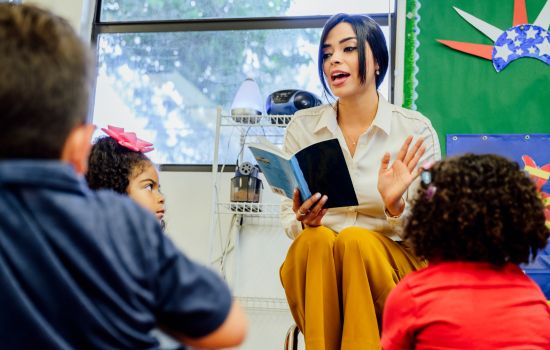
10. Teaching Proficiency Through Reading and Storytelling (TPRS)
TPRS fully embraces the Natural Approach’s vision of language acquisition and its prerequisites (CI, the affective filter and so on). Building on Krashen’s theory of language acquisition, it has created a precise strategy to encourage L2 acquisition, referred to as “the recipe.” In the TPRS class, the teacher introduces a simple story through statements (e.g., “There was a boy.”) accompanied by pictures that illustrate the story. The teacher then invites the students to become cocreators of the story initially by answering simple questions and later by adding characters and details. The recipe is summarized as ACT, ACT, Describe.
ACT stands for Add, Circle and Triangle. Characters or details are added to the story by the teacher and the students; the teacher subsequently asks questions to the whole class that responds chorally with one-word answers (yes, no, etc.). This is known as circling. In the triangling phase, the teacher zeros in on a single student, asks them questions and demands full-sentence answers. When the story has developed enough, the teacher asks the students to describe what has happened so far. This is known as DtS or “Describe the Situation.”
TPRS is a very flexible method that can be applied even to ESP. Zayde Gonzales, TPRS teacher and teacher trainer, explains: “We co-create stories with students of different ages, countries, cultures and needs. For businesspeople, we use the high-frequency words of their sector, business or country. In the end, they can handle how to communicate effectively according to their needs.”
Learn more about TPRS, a language acquisition strategy that’s growing in popularity.
11. CLIL (Content and Language Integrated Learning)
CLIL was developed during the 1990s to integrate language learning and content learning. The approach was partly inspired by Canadian bilingualism and immersion programs in North America. It emerged from the historical context of an increasingly plurilingual, multicultural and economically interdependent Europe. In an extensive review of CLIL’s background, principles and practices, Zehra Gabillon states that its “well-defined key principles distinguish it from other practices. CLIL aims to (a) respect plurilingual teaching philosophies, (b) consider language, content, communication, context and cognition as an inseparable unified entity, (c) create naturalistic learning environments, (d) provide tasks that promote cognitive engagement and creativity, (e) allow collaborative knowledge building, (f) promote dialogical interaction and (g) develop awareness of self and others.”
CLIL was initially created as a foreign language teaching method that could respond to the specificity of local needs and contexts. However, CLIL is not a method. It is rather an approach characterized by its flexibility. Any method can be integrated into CLIL. Also, CLIL is not simply a language teaching approach strictly because language competence is not its only aim. In Gabillon’s words, “learners’ active participation, cognitive skills development (i.e., critical thinking and problem-solving), content acquisition, inter- and transcultural competencies and language skills development are all considered equally important.”
Bridge provides Specialized Certification in CLIL as well as engaging sample CLIL lesson plans for the ESL/EFL classroom.
Learn more about the benefits of CLIL in bilingual education.

12. Task/Project-Based Learning
Task-Based and Project-Based Learning share the idea that students learn best when engaged in activities that are meaningful and purposeful. This idea can be traced back to the pragmatist philosophy of John Dewey and his student William Heard Kilpatrick. Kilpatrick developed the so-called Project Method, an approach to education in which the teacher acts more as a facilitator than an authority figure and learning activities center around the needs and interests of the students.
In language teaching, TBL/PBL became popular as part of Communicative Language Teaching. It aimed to create a student-centered classroom that encouraged collaboration and communication. The primary difference between TBL and PBL is one of scale. While TBL focuses on single tasks that are attainable in a short amount of time, PBL selects a topic for a project that may last from one week to a whole semester or even a school year, and that often consists of several smaller tasks.
Both TBL and PBL involve different stages. In TBL, during the pre-task stage, the teacher introduces the topic and task and scaffolds the language. In stage two, students perform the task in pairs or small groups and present it to the class. This stage focuses on communicating results in the target language rather than on the accuracy of the language. In stage three, the teacher attends to the language issues that may have come up during the presentation, thus focusing on accuracy.
Similarly, PBL involves a phase one, during which the teacher introduces the topic to be investigated and sets up the activities through which students will carry out the investigation; in phase two, the students are given access to resources to work on the project; in phase three, students exchange ideas, collaborate and communicate findings; and finally, in phase four, they produce a final product in the form of a poster, a video, a presentation, a blog and so on. TBL and PBL allow language to emerge naturally as a byproduct of the class activities. They also encourage collaboration, communication, creativity and critical thinking.
Ready to learn more about Task-Based Learning? Check out this guide to the popular teaching method.
13. Flipped Classroom
The Flipped Classroom approach to learning is not a novel idea, but it has become more widely used since the introduction of technology in education and the availability of online resources. The concept underlying it is that class time can be more efficiently used if students study the class material in advance instead of being exposed to it during a lecture. Class time can then be used for analyzing, discussing and practicing the study material. One of the advantages (and challenges) of the Flipped Classroom is that it requires students’ active participation and fosters Bloom’s Taxonomy higher-order thinking skills like critical thinking and problem-solving. Instead of being spoon-fed information by the teacher, students must confront the material directly and come to class ready to discuss it.
Learn more about effective ways to teach critical thinking skills in the ESL classroom.
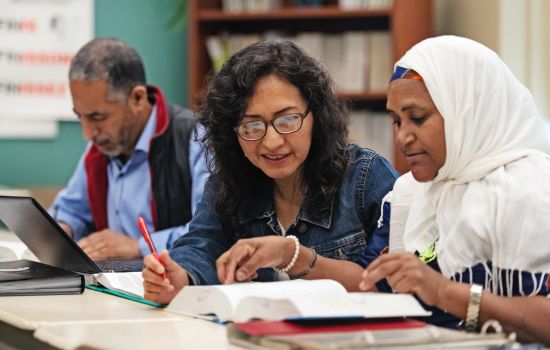
14. Blended Learning
Blended Learning is a common teaching strategy in online classes. It shares some aspects with the Flipped Classroom because students are expected to complete some classwork independently. As with the Flipped Classroom, Blended Learning tends to work better with older, highly motivated students. It combines synchronous and asynchronous activities. Students complete skill-building activities or homework on their own time, and class time is devoted to listening, speaking or other activities that necessitate interaction with the teacher and other students. Like the Flipped Classroom, Blended Learning allows for more efficient use of the limited class time. Blended Learning has become quite popular in recent years after the pandemic and the lockdowns forced most students to work from home.
15. Lexical Approach: Corpora and Data-Driven Learning
Advancements in technology have propelled the development of Corpora and Data-Driven Learning. Corpora, collections of examples of authentic language derived from newspapers, recordings of conversations, literature, etc., are the main tool of instruction used in the Lexical Approach. As explained in Methods of Language Teaching, the approach is based on the idea that most of the language people use is not made up of grammatical structures but of “chunks,” of expressions that typically have a noun, verb or adjective, typically with a preposition (e.g., by the way) and lexical collocations, or pairing words (e.g., prices fell, grave danger, fast food).
The spread of personal computers and the internet has helped to identify high-frequency words and their standard collocation, and teachers can use this information to raise learners’ awareness of the lexical nature of language. Even teachers who don’t share the Lexical Approach’s view of language can use Corpora to select the lexicon and phrases they want to focus on. Activities often include first and second language comparisons and translation, repetition and recycling of activities to practice words and expressions that have been learned, using context to determine meanings of unfamiliar words and identifying language patterns and collocations.
This approach may be useful for Business English and ESP learners, as there are so many lexical collocations specific to different industries and often, the purpose of learning English will be to communicate effectively within that sphere.
Combining technology with learning methodologies
Many of the learning methodologies mentioned above can be used in a brick-and-mortar classroom or an online one. In either case, many teachers integrate technology into their instruction. The introduction of technology in the ESL/EFL classroom has added many great tools to the language teacher’s arsenal.
We were able to move the time-consuming study of grammar to a self-paced sequence where we used videos.
The Flipped Classroom, Blended Learning and Corpora and Data-Driven Learning are the most obvious examples of tech-supported instruction, but technology can supplement any teaching methodology.
Robert Szabo, VP at Learnship, a B2B language training provider, described some of the ways his company uses technology to serve learners. “We created a cross-platform curriculum,” he said. “So, there’s the flipped classroom. We were able to move the time-consuming study of grammar to a self-paced sequence where we used videos. We basically recorded teachers with subtitles explaining a set piece.”
The technology adds something that traditional classroom teaching doesn’t necessarily have because you’ve got a holder for all these videos, audio and images to take a bit of load off the acquisition phase and put more emphasis on the production phase.
Szabo gave the example of teaching the present perfect. “You can record a strong set-piece explanation of the usage of the present perfect,” he said. “And then you create exercises related to the video in terms of meaning, form and pronunciation.”
The idea behind this approach is that students will have watched the video, learned the content, viewed the language used in context, completed the exercises and then show up to class prepared, already familiar with the present perfect tense.
“The technology adds something that traditional classroom teaching doesn’t necessarily have because you’ve got a holder for all these videos, audio and images to take a bit of load off the acquisition phase and put more emphasis on the production phase,” Szabo said.
He warned that producing a strong, robust explanation takes practice. A first-year teacher may struggle, but over time, creating robust recordings like these becomes easier.

EdTech Consultant Miriam Plieninger also praised the use of technology to aid classroom learning.
Machine feedback to learner input is quicker and more scalable than teacher feedback, and through AI, increasingly can handle input that does not need to match pre-defined solutions or distractors.
“Asynchronous tech elements provide additional learning opportunities independent of time and place,” she said. “They can support a flipped classroom approach, in which learners benefit from guided self-study to prepare for an in-person class (allowing for more real language production time in class).”
She also pointed out the benefits of documentation and feedback that come with using technology.
“Tech can allow instant documentation of what’s discussed/studied. Machine feedback to learner input is quicker and more scalable than teacher feedback, and through AI, increasingly can handle input that does not need to match pre-defined solutions or distractors,” Plieninger said. “Tech solutions have the potential to personalize learning paths at scale (based on learning targets + current strengths and weaknesses). All these elements can be orchestrated and quality-controlled by in-person instructors and can supplement in-person teaching.”
The new kid on the block – ChatGPT
And then there’s the new kid on the block in the technology field – ChatGPT and similar AI chatbots. Teachers will have to get acquainted with this tool because even if they choose not to use it, students will, and sometimes for nefarious purposes. So, what are the possible applications of AI and Chat GPT in the language classroom?
You can say, ‘Okay, I want to listen to a woman with an Indian accent or listen to a man with a British accent,’ for example. So, there’s this personalization story for the learner.
“It’s a very powerful tool as long as you have very specific prompts and a very careful editing phase,” Szabo said. “What you can do with ChatGPT, and what we have done, is create these prompts in such a way that you can start with elicitation questions. And you can get those elicitation questions from ChatGPT. You can also get it to gauge the proficiency level of the wording that it uses. You can ask it to include certain vocabulary sets. You can ask it to include certain grammar constructions and get it to create your exercises.”
Szabo said he always tells people that “it’s like a pneumatic drill. You can destroy the road and your feet if you don’t know how to use it. It’s a powerful tool. And I think it’s the same with ChatGPT.”
Another interesting application of AI and ChatGPT is that they can expose learners to different varieties, accents and registers of the English language. Szabo pointed out, “You can say, ‘Okay, I want to listen to a woman with an Indian accent or listen to a man with a British accent,’ for example. So, there’s this personalization story for the learner.”
Expert consensus: Multiple methodologies are needed
Historically, there has been a strong continuity in the approaches and methodologies of English Language Teaching. Each approach/methodology arose as a reaction to or a development of previous ones. Each approach/methodology seems to have emerged from the cultural and theoretical climate of its time and as a response to changing needs.
If the teacher is teaching ‘in country,’ then it would be wise to be flexible and prepared to adapt to the language/culture in which they find themselves and in relation to the type of institution they are working in.
However, each has contributed aspects that have been incorporated into teaching and have persisted over time. It stands to reason, then, that teachers should be acquainted with the various approaches and strategies and extract from them whatever serves their specific instructional needs.
John Hughes, President of TESL Canada, said, “If the teacher is teaching ‘in country,’ then it would be wise to be flexible and prepared to adapt to the language/culture in which they find themselves and in relation to the type of institution they are working in. For example, if you are working in China, and the program is very exam/assessment focused, and class sizes are large, CLT may not be the answer! If I can turn that around, in the UK HE sector, we expect/desire that students are active participants, especially at the university level, and there is a tendency that students from certain countries/cultures are not really used to that, and it is quite a steep learning curve.”
All these methodologies provide many more opportunities for interaction compared to other methodologies, and we know that language is learned when used to meaningfully interact with others.
Hughes provided an example involving the skill of critical thinking. “The issue of engaging with and demonstrating critical thinking, for example, can be tough and not what is expected in their ‘home’ environment,” he said. “Likewise, group work, especially if the nationalities and cultures are more mixed, can need support and, at times, intervention from the teacher to keep everyone on track, in a TBLT project task, for instance. So, for teachers, try to be patient, supportive and sensitive to the students in your cohort.”
Peterson of Westcliff University agreed that multiple methodologies are needed for instruction but described some methods he favors, including communicative language learning, task-based learning and project-based learning.
“All these methodologies provide many more opportunities for interaction compared to other methodologies, and we know that language is learned when used to meaningfully interact with others,” he said. “Using these methodologies, you are more likely to have a student-centered class in which students are actively engaged rather than a teacher-centered class where students are passive learners.”
Jennifer Maguire, Bridge B2B Content Marketing Manager and 10-year English teacher believes that when selecting a methodology, “teachers should keep in mind the individual learning styles of their students, their short and long-term goals and their interests. The methodologies I have found to be most effective for language learners are small-group, collaborative, task-based and project-based learning. In any case, I think it’s important that classes be student-centered.”
So, how can teachers keep abreast of the many ESL methodologies they should know? Bridge has online TEFL courses that are accessible all over the world, many of which can be part of university pathways. Additionally, the monthly Expert Series webinars, which provide Certificates of Professional Development, feature teaching insights from leading experts in the ELT industry around the world.





